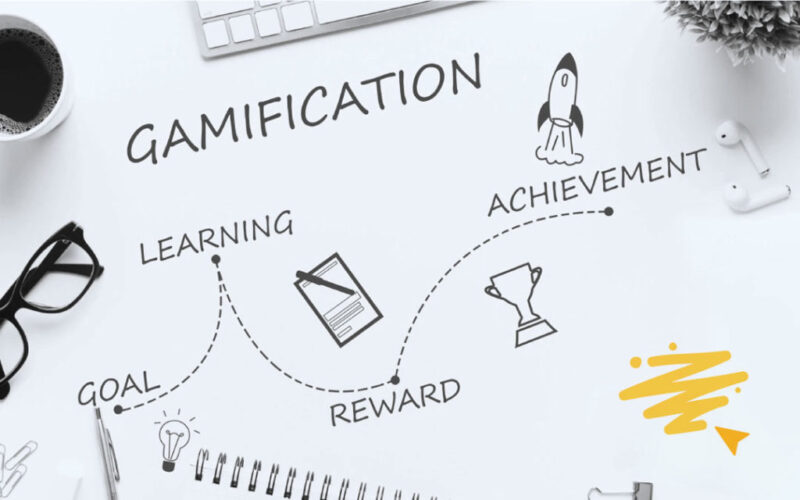As we traverse deeper into the digital age, businesses and institutions are harnessing the power of play, turning mundane tasks into engaging experiences. The secret? Gamification. This approach, prevalent across a spectrum of industries, seeks to motivate and engage users by incorporating game-like elements into non-game settings. We are now going to delve into the intricacies of this captivating trend and its transformative influence across diverse sectors.
Page Contents
What is Gamification?
Gamification, at its core, is the art of infusing game mechanics into non-game contexts. Think of it as adding levels, points, or badges to everyday tasks. By doing so, businesses not only make activities more enjoyable but also inspire users to stay committed and achieve desired outcomes.
These gamified elements not only increase the excitement and anticipation for players but also encourage longer play sessions and more frequent returns to the platform. Gamification layers add depth to the experience.
Although many associate games with entertainment, the psychology behind them can drive deep engagement. Gamification exploits these psychological triggers — such as achievement, competition, and collaboration — to heighten user interest and participation. This strategic move leads to enhanced user satisfaction, loyalty, and often, tangible business results.
1. Gamification in Education

In education, gamified approaches have transformed traditional teaching methods. By introducing elements like points and leaderboards, educators can foster an environment where students actively compete, collaborate, and remain motivated.
Engaging students, especially in an online learning environment, can be challenging. But with gamified modules, educators can track progress, reward achievements, and provide instant feedback. This feedback mechanism encourages continuous learning and participation, ensuring students remain connected and driven.
Though some critics argue that gamification might make education frivolous, its results speak volumes. Schools and institutions that have embraced this approach report higher student participation, improved retention rates, and a more collaborative learning environment.
2. Gamification in Human Resources
Human resource departments have begun leveraging gamification to recruit, train, and retain employees. Consider the hiring process; companies now use gamified assessments, offering potential hires a fun way to showcase their skills and fit.
Training programs, traditionally seen as tedious, benefit immensely from gamified elements. By introducing levels, challenges, and rewards, businesses can ensure employees not only learn but also enjoy the process. This makes skill acquisition and knowledge retention more effective.
Moreover, employee engagement programs have started to feature game mechanics to boost morale, foster collaboration, and encourage best practices. From fitness challenges to innovation contests, gamified platforms keep employees motivated and connected, significantly enhancing workplace productivity.
3. Gamification in iGaming

The iGaming industry, inherently rooted in play, has further expanded its horizons with gamification. Today’s online gaming platforms often feature narratives, missions, and loyalty programs to heighten player involvement.
Introducing narratives or stories in games provides players with a purpose, ensuring they remain committed to the game. These tales give context to challenges, enhancing the overall gaming experience and driving player loyalty.
Beyond just narratives, leaderboards and tournaments amplify the competitive spirit, enticing players to achieve more, play longer, and ultimately, spend more. Such strategies not only bolster player engagement but also boost the industry’s profitability.
The gambling industry, always at the forefront of innovative user engagement, has significantly adopted gamification techniques to elevate the gaming experience. By incorporating elements traditionally found in video games — such as storylines, progress bars, avatars, and unlockable content — gambling platforms have succeeded in creating a richer, more immersive environment for users. If you are interested in online gambling, top-rated online pokies for real money are worth checking out.
4. Gamification in Marketing
Marketing, always a dynamic domain, has found new vigor with gamified campaigns. Brands now employ challenges, quizzes, and interactive experiences to captivate consumers, driving brand awareness and loyalty.
Think of loyalty programs where consumers earn points for purchases. Such systems nudge customers to spend more to attain rewards or reach higher membership tiers. These mechanics amplify customer commitment, directly translating to increased sales and brand loyalty.
However, gamification in marketing isn’t restricted to loyalty programs. Interactive ad campaigns, social media challenges, or branded games can create buzz, virality, and customer engagement. Such strategies not only promote products but also foster a deeper brand-customer relationship.
5. Gamification in Healthcare

The healthcare sector, often viewed as serious and straightforward, has seen remarkable transformations with gamified interventions. Health apps now feature challenges, badges, and rewards, pushing users towards healthier habits and lifestyle choices.
Consider fitness trackers. By setting daily step goals or creating weekend challenges, these devices nudge users to move more, compete with friends, and remain conscious of their health. This not only promotes physical well-being but also ensures users remain engaged with their health trackers.
Beyond fitness, gamified platforms help in areas like mental well-being, medication adherence, or even medical training. By making health management more interactive, gamification has the potential to revolutionize how we approach and maintain our well-being.
6. Other Industries that Use It
Travel and tourism sectors have jumped onto the gamification bandwagon, with apps offering badges for visiting destinations or completing travel challenges. Such mechanisms not only boost app engagement but also promote travel and exploration.
The finance sector, often seen as rigid, employs gamified platforms for financial literacy and investment. Apps offering challenges or rewards for saving, investing, or understanding finance concepts have become increasingly popular.
Retail is not left behind either. Imagine walking into a store where you earn points for trying out outfits, giving feedback, or making purchases. Such experiences enhance customer engagement, pushing them to visit more and buy more.
Even the aviation industry has used gamification by using flight simulators to teach students how to fly aircraft.
Future Outlook

So, where does the road lead for gamification? With advancements in technology, especially in virtual and augmented reality, the scope for gamified experiences only expands. Imagine immersive learning environments, life-like training simulations, or marketing campaigns that blur the lines between reality and play.
As the digital landscape becomes increasingly competitive, brands and institutions will look for innovative strategies to stand out. Gamification, with its unique blend of psychology and play, is poised to be a frontrunner in this quest for engagement and loyalty.
Parting Thoughts
In a world craving connection and engagement, gamification emerges as a beacon of innovation. From classrooms to boardrooms, from smartphones to smartwatches, the rhythm of play reverberates, ensuring that mundane tasks transform into memorable experiences. As we stand at the cusp of further digital evolution, gamification’s role becomes even more pivotal, promising a future where work, learning, and play merge seamlessly.





